Main Menu · Search ·Current Issue ·Contact ·Archives ·Centennial ·Letters to the Editor ·FAQs
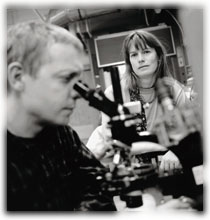 Maciej Zwieniecki and Michele Holbrook Black and white photograph by Jim Gipe Maciej Zwieniecki and Michele Holbrook Black and white photograph by Jim Gipe |
In this lab, they ask big questions. To get the answers, they sometimes do big experiments. Foster himself, for example, is the only person in the scientific literature ever to have simulated a hurricane. He did it right in the middle of the Harvard Forest.
"There is an over-arching theme to all of the research," Foster explains. "Basically, we are trying to look at the interplay of environmental change, human activity, and natural disturbance. The objective is to use a variety of approaches to understand current conditions--structure, composition, and change--and, using that information, to anticipate future change."
In other words, Foster wants to see how his forest responds to various outside forces. One category of forces is products of human activity, such as acid rain or global warming. But forests are also subject to natural disturbances--some catastrophic--such as hurricanes.
On average, southern New England experiences a severe hurricane every 50 to 100 years. The last one that roared through the Harvard Forest came by in 1938. Foster wanted to study the impact of a hurricane on a forest like his, and he didn't want to have to wait for the next one. So he started to ask around. "When we first proposed doing it, most scientists said, 'Forget it. Impossible.' Then I talked to some loggers about it, and they said, 'No problem.' It turns out that they do this all the time in logging. We got so we could pull down a tree a minute."
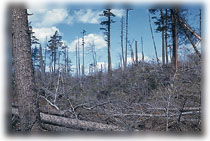 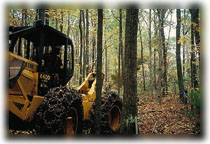 Top: destruction in Pisgah Forest after the 1938 hurricane. Bottom: a skidder's winch and cable are used to create a simulated hurricane in 1990.Top: HARVARD FOREST ARCHIVES; bottom, JOHN O'KEEFE Top: destruction in Pisgah Forest after the 1938 hurricane. Bottom: a skidder's winch and cable are used to create a simulated hurricane in 1990.Top: HARVARD FOREST ARCHIVES; bottom, JOHN O'KEEFE |
In October 1990, they started toppling trees. Eventually, using winches and other heavy equipment, Foster and his team managed to pull down some 250 trees, all in a northwesterly direction, to mimic the wind-throw pattern observed after the 1938 hurricane. In the process, they damaged but did not uproot another 400 trees.
In order to test the impact of human activity at the same time, Foster and the other researchers were busy elsewhere in the forest, trying to simulate the effects of acid rain and global warming. To expose one part of the forest to the effects of acid rain, researchers in certain experimental plots have been adding nitrogen (by spraying ammonium nitrate in concentrated, dissolved form) at levels equivalent to those observed on stressed hillsides in Germany. And to study soil warming, researchers buried electric cable in another area to raise the soil temperature a few degrees. That is why hikers in the forest sometimes come across isolated cabins bristling with antennas and wires (as well as locks, to keep bears out), or signs warning of high voltage.
In addition to such experimental manipulations, the research program also involves retrospective studies, to figure out what has happened to this forest over the past hundreds and thousands of years, and elaborate observational studies. Some of these use passive monitoring stations that automatically collect data on temperature, precipitation, gas exchanges, and the like. Other studies are more active. The scaffolding tower, for example, affords access to the treetops so that scientists can examine individual leaves or a specific patch of bark.
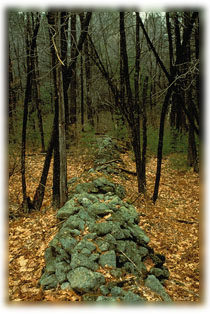 Some of the 10 miles of stone walls attesting to the now-reforested land's use for farming in the past. JOHN O'KEEFE Some of the 10 miles of stone walls attesting to the now-reforested land's use for farming in the past. JOHN O'KEEFE |
Much of this effort came together in a recent scientific article in the journal BioScience. There Foster noted that when he tore down the patch of forest to simulate the hurricane, the result was a major "vertical reorganization of the canopy and foliage"--in other words, lots of trees were toppled and left akimbo--but the forest stayed pretty healthy through it all.
That finding was somewhat reassuring, but also, at first, puzzling, because it was at odds with the conventional wisdom about the 1938 hurricane, which was seen as a major disaster that resulted in dramatic shifts in forest composition and even changes in the flow of the region's rivers. As it turned out, the answer lay in the retrospective studies. After the 1938 hurricane, folks in central New England did not just stand around and measure changes in biomass. As practical and thrifty people, they got busy harvesting all that blown-down timber. In fact, they carried out the single largest timber salvage operation in U.S. history up to that point, putting in 4.5 million workdays and taking out 1.5 billion board feet of timber. As a result of all that human activity, the natural disturbance of the hurricane was magnified many times.
What Foster proved in his pull-down experiment is that a forest can cope quite nicely with a natural disturbance like a hurricane (at least as long as people don't interfere). But his studies also show that the same forest faces a much greater challenge from "novel stresses" such as man-made pollution. After all, Foster points out, the forest evolved in an environment in which hurricanes are a sporadic but persistent feature. But whether it can evolve to cope with acid rain or global warming is unclear. The answer may lie in some anemometer or hygrometer that is even now silently recording data out in Petersham.
Why does Harvard own its own forest?
The answer to that question is simple. Like many other interesting and useful things the University owns, the forest was given to Harvard.
The core of the land that makes up the Harvard Forest today once belonged to a man named John Sanderson, who started clearing it in 1768--using ox and ax, he started felling the red oak, chestnut, red maple, white ash, paper birch, pine, and hemlock that covered the hills (see "From wheat to pines to oaks and ashes on John Sanderson's farm," February 1974, page 30). He and his heirs kept at it for the next 80 years, expanding their acreage along the way. Eventually, they cleared 99 percent of their 3,000 acres (just as farmers do today in the tropics), and they built no less than 10 miles of stone walls, which can still be seen among the undergrowth.
 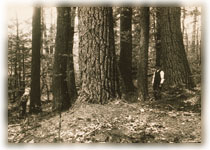 Impressive examples of old growth in Pisgah Forest in 1917, prior to the hurricane. Bottom: hauling logs in the 1920s. HARVARD FOREST ARCHIVES Impressive examples of old growth in Pisgah Forest in 1917, prior to the hurricane. Bottom: hauling logs in the 1920s. HARVARD FOREST ARCHIVES |
In 1845 the Sandersons sold the land, which went through a series of hands until 1876, when it passed to a religious communal group known as the Adonai Shomo. The members added to the holdings until they went bankrupt in 1897.
Meanwhile, a Harvard alumnus named James Brooks, LL.B. 1858, had discovered Petersham and started buying up land in the area, including the old Sanderson place. In fact, he liked Petersham so much that he encouraged some of his Harvard friends to come out, and they, too, bought parcels in the area, which they used as summer getaways. Brooks himself went so far as to buy the town's inn. According to Foster, many of the current Friends of Harvard Forest are descendants of those Harvard families.
In 1907, Brooks gave Harvard the property that still makes up the bulk of the University's forest. In doing so, he expressed the wish that the land be used to establish a school of forestry and that it be kept open as much as possible to the general public. It is unknown, of course, what Brooks might think of his forest now, but he would have to be impressed by the research that goes on there: the abundant and varied arboreal community has attracted a research community that is just as diverse. By all accounts, the forest is a one-of-a-kind resource.
Michele Holbrook '82, a whole-plant physiologist, describes the forest as an indispensable part of her work, which explores the mechanical properties of plants, especially the way they move water from root to tip. I ask if she could do her research on a window sill in Cambridge, or in a greenhouse. "Absolutely not. We need to study an intact system. Some studies require that it be in its historical setting," says Holbrook, an assistant professor in OEB. "We're not studying just one plant at a time. We need plants in their natural environment, subject to onslaughts by weather and insects, and competition from other trees. You can't re-create that in a greenhouse."
Trees, Holbrook explains, are like giant pumps for moving water from the ground to the uppermost leaves of the canopy. They perform this impressive feat--hoisting thousands of gallons of water 80 or 100 feet in the air--by tapping solar energy. During photosynthesis, leaves evaporate water into the air. As each water molecule is given up to evaporation, another molecule is drawn upward to take its place, and so on until a molecule completes the passage from the deepest root to the highest tip. Holbrook is investigating the mechanical problems trees encounter when, for example, they develop a gap in the water-transfer system, like an embolism that blocks the uptake of water. Because trees give up water as they take in carbon dioxide (CO2), her research is the flip side of studies on carbon exchange being done by other Harvard scientists affiliated with the forest.
The forest, in fact, attracts researchers from all across New England who meet and collaborate and share ideas in ways they would not if each were minding a separate project on a window sill. "One of the nice things about the forest is that it's a regional site," Holbrook explains. "It's a great place to interact with colleagues. It's an exciting crossroads."
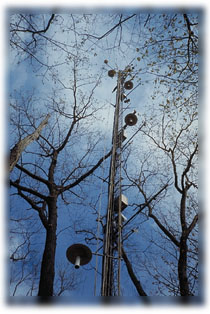 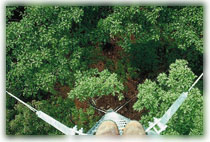 Views from the forest floor and from the top of the tower Steven Wofsy has equipped to monitor the flow of carbon dioxide through the woods. PETER SCHOONMAKER Views from the forest floor and from the top of the tower Steven Wofsy has equipped to monitor the flow of carbon dioxide through the woods. PETER SCHOONMAKER |
She says the forest offers other advantages, too. There are the field trips that introduce undergraduates to the excitement of forest botany. Holbrook recalls discovering the forest during a freshman seminar. "I thought, 'Wow, they've got this place out in the country.' When I was an undergrad, I took the bus out there, and I would stay in the dorms. It was a little bit lonely. It was a lot quieter then." Now, busloads of Harvard students arrive regularly, year-round.
Holbrook argues that it is important, for both research and teaching, that the forest is owned by Harvard. "You can't set up a research institute in a state park," she says, noting that some sections of the forest must be placed off-limits to visitors for years at a stretch, which would be impossible on state or federal land. "The forest gives a lot back to Harvard," Holbrook says. "It isn't just a bunch of trees where a bunch of people go out and take measurements."
Steven Wofsy, Ph.D. '71, McKay professor of atmospheric and environmental sciences, agrees about the forest's importance.
"My work has been motivated by the need to understand the global budget for CO2, which has been much in the news lately," Wofsy explains. "Some people think that forests such as Harvard's, which are regrowing after agricultural exploitation in the nineteenth century, are important worldwide in taking up CO2 emitted by fossil-fuel combustion. We wanted to test this notion quantitatively at a well-understood site."
"In 1989, we started a time series of long-term measurements in which we determine--every half hour--the quantity of carbon dioxide leaving or entering the forest, using technologically advanced methods to make direct measurements. We also measure a wide variety of environmental factors, such as incoming sunlight, deposition of nutrients from the atmosphere, pollutant concentrations, et cetera. We wanted to understand how much carbon dioxide is being taken up by the forest, and to explain why this amount--about 2 metric tons of carbon in the form of CO2 for each hectare every year--is being stored there. By observing over the years in New England's variable climate, we wanted to see how the ecosystem responds to climate change."
These experiments are at the forefront of the international race to figure out whether the impacts of human industrial activity on the environment are reversible. "They have shown that the forest is a quite large sink for atmospheric CO2," Wofsy says. "We observed that the forest takes up more carbon when the climate is unusually warm and less when it is cold, opposite to predictions from models but consistent with data from the global CO2 monitoring network." They were able to explain why this is so, based on the length of the growing season, variations in cloudiness, and other factors. The answers have a direct bearing on whether Earth can bounce back from the twentieth century.
Wofsy describes his experiment as the first and longest-running in a network of similar sites, which began in response to the initial successes generated at the Harvard Forest. "The forest is therefore important to an international scientific community," he emphasizes. "As we extend to longer time scales and more complete understanding of the system, the [Harvard Forest] site will become more important."
Wofsy also agrees with Holbrook about the importance of Harvard's ownership of the land. "It would not be possible to do this in another forest," he states flatly. "The professional staff and direct funding from Harvard have been essential, and the work would cease if this support were withdrawn. The flexibility for construction of facilities has been very helpful."
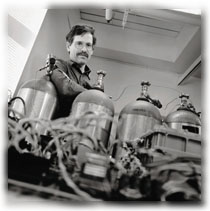 Steven Wofsy, in his laboratory in Cambridge. Black and white photograph by Jim Gipe Steven Wofsy, in his laboratory in Cambridge. Black and white photograph by Jim Gipe |
He points to the case of a "sister site" in central Maine, which is being run by the U.S. Forest Service on experimental forest lands owned by Great Northern Paper Incorporated. In the past, paper companies left their trees relatively undisturbed for long periods of time; today, the companies that operate across New England's great North Woods are more inclined to resort to shorter-term expediencies, such as clear-cutting and selling land to developers. When that happens, the once-stable North Woods become useless for long-term research.
"We have had similar problems at our other site, in Manitoba, requiring extensive pleading, negotiations with Canadian authorities, and expense," Wofsy says. "If NASA had not negotiated an international agreement with Canada, that site would not exist. We don't need international or governmental approval at Harvard Forest."
In another part of the forest, David Foster shows me a glimpse of the future. On a steep hillside, we make our way up through a hemlock glen. At our feet, almost nothing can find enough sunlight to grow under the dense canopy of the trees, some of them easily 400 years old. There are only mosses, some ferns, and a few mushrooms among the generation upon generation of hemlock needles.
But according to Foster, change is coming. That glen, indeed the entire Harvard Forest and all the woods in New England, stand in the path of a pest called the hemlock woolly adelgid, an insect from Japan that can kill a healthy hemlock in a few seasons (see "The Chinese Contraceptive Bush...and Other Remarkable Trees and Shrubs of the Arnold Arboretum," July-August 1996, page 58, and "Damage Report," July-August 1997, page 71). Although the infestation has not yet reached north-central Massachusetts, many owners of hemlock stands in New England are engaged in preemptive logging.
Not here, though. Researchers at the Harvard Forest are already at work on the question of succession: What will happen next? Among all those needles are the seeds of dozens of species, all poised for takeoff when the big evergreens fall.
"This kind of thing has happened before," Foster says, drawing on his lengthy perspective. "It's even happened to hemlocks before--about 5,000 years ago. It was probably some pest from the west. The good news is that hemlock was able to evolve a resistance to this pathogen. The bad news is, it took a thousand years to happen. In geological and evolutionary time, that's nothing."
With a shrug of scientific equanimity, Foster plunges off downhill, back into his forest.